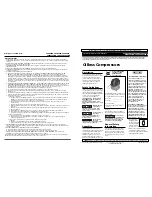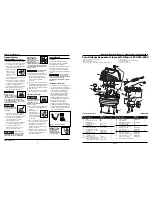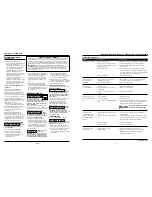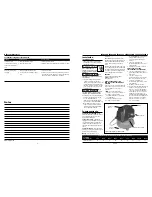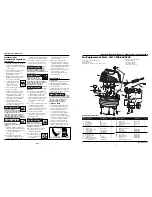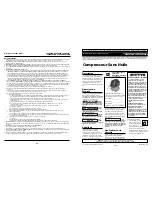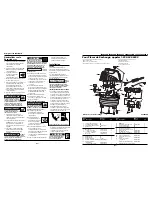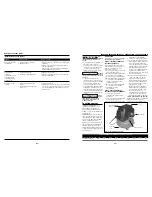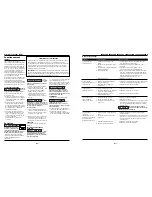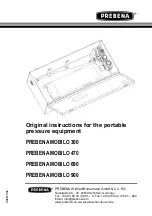
21 Sp
4
Operation
(Continued)
continuously, the compressor will cycle
on and off automatically.
In the OFF position, the pressure switch
cannot function and the compressor
will not operate. Make sure switch is in
OFF position when connecting or
disconnecting power cord from
electrical outlet.
ASME SAFETY VALVE
Do not remove or
attempt to adjust
the safety valve!
Check the safety valve by performing
the following steps:
1. Plug the compressor in and run until
shut off pressure is reached (see
Operating Procedure).
2. Wearing safety glasses, pull the ring
on the safety valve to release
pressure from compressor tank. Use
your other hand to deflect fast-
moving air from being directed
toward your face.
3. The safety valve should
automatically close at approximately
40-50 PSI. If the safety valve does not
allow air to be released when you
pull on the ring, or if it does not
close automatically, it MUST be
replaced.
Maintenance
Disconnect power
source then release all
pressure from the
system before
attempting to install,
service, relocate or perform any
maintenance.
Check compressor often for any visible
problems and follow maintenance
procedures each time compressor is
used.
Safety valve must
be replaced if it
cannot be actuated or it leaks air after
ring is released.
!
WARNING
!
WARNING
!
WARNING
1. Turn compressor off and release
pressure from system. (To release
pressure from system, pull ring on
ASME safety valve. Deflect escaping
air by shielding valve with one hand
as you pull ring with other hand.)
Pull ring until tank is empty.
A large amount of
fast moving air will
be released when the safety valve is
opened with pressure in the tank. Wear
ANSI approved Z87.1 safety glasses.
2. Drain moisture from tank by opening
drain valve underneath tank. Tilt
tank to remove all moisture.
3. Clean dust and dirt from tank, air
lines and pump cover while
compressor is still OFF.
LUBRICATION
This is an oilless type compressor
requiring no lubrication.
THERMAL OVERLOAD PROTECTOR
This compressor is
equipped with an
automatic reset thermal overload
protector which will shut off motor if it
becomes overheated.
If thermal overload protector shuts
motor OFF frequently, make sure that
the compressor is used in a clean, well-
ventilated area where temperature will
not exceed 100° F.
If the thermal
overload protector
is actuated, the motor must be allowed
to cool down before start-up is possible.
The motor will automatically restart
!
CAUTION
!
CAUTION
!
CAUTION
without warning if left plugged into
electrical outlet and unit is turned on.
STORAGE
1. Drain tank of moisture.
Drain moisture from
tank daily. Failure to drain tank can
result in weakening due to rust and
bursting.
2. When not in use, store compressor in
a cool dry place.
3. Disconnect hose and hang open ends
down to allow any moisture to drain.
!
WARNING
MOISTURE IN COMPRESSED AIR
Moisture in compressed air will form into droplets as it comes from an air
compressor pump. When humidity is high or when a compressor is in continuous
use for an extended period of time, this moisture will collect in the tank. When
using a paint spray or sandblast gun, this water will be carried from the tank
through the hose, and out of the gun as droplets mixed with the spray material.
IMPORTANT:
This condensation will cause water spots in a paint job, especially
when spraying other than water based paints. If sandblasting, it will cause the
sand to cake and clog the gun, rendering it ineffective. A filter in the air line
(MP3105), located as near to the gun as possible, will help eliminate this
moisture.
Oilless Compressors
FP202800, FP202900, FP202897, FP202999DB, and FP202999DQ
Guía de diagnóstico de averías
Problema
Posible(s) Causa(s)
Acción a tomar
1. El interruptor está en la posición OFF
(apagado)
2. No hay corriente eléctrica en el
tomacorriente de la pared
3. El compresor alcanzó la presión de
corte automático
4. Motor recalentado
6. Interruptor de presión defectuoso
1. Falta de ventilación adecuada/
temperatura ambiente demasiado
alta
2. Fallaron las válvulas del compresor
1. El tanque no está nivelado
2. Cojinete defectuoso en la excéntrica o
en el eje del motor
3. El aro del cilindro o pistón está
desgastado o marcado
1. Válvula de drenaje floja
2. Fugas en la válvula de retención
3. Conexiones flojas (accesorios, tubería,
etc.)
1. Uso excesivo de aire, el compresor es
demasiado pequeño
2. Conexiones flojas (accesorios, tubería,
etc.)
3. Válvulas de entrada averiadas
4. Aro del pistón desgastado
1. Asegúrese de que el compresor esté enchufado y que
el interruptor esté en la posición ON (encendido)
2. Revise el disyuntor o fusible en el panel de
electricidad.
3. Libere aire del tanque hasta que el compresor se
reinicie automáticamente.
4. Deje que el compresor se enfríe durante
aproximadamente 30 minutos para que el interruptor
térmico de sobrecarga vuelva a su posición normal.
Asegúrese de que el compresor esté funcionando en
un área limpia y bien ventilada donde la temperatura
no exceda los 100ºF.
6. Cambie el interruptor de presión
1. Mueva el compresor a un área limpia y bien ventilada
donde la temperatura no exceda los 100ºF.
2. Cambie el ensamblaje de la bomba
1. Nivele el tanque
2. Cambie el ensamblaje de la bomba
3. Cambie el ensamblaje de la bomba
1. Apriete la válvula de drenaje
2. Cambie la válvula de retención
3. Revise todas las conexiones con una solución de agua
y jabón. Si se detecta una fuga, apriete. O quite la
conexión y aplique cinta para tuberías a las rocas y
vuelva a armar.
No desarme la válvula
de retención. Si hay
aire en el tanque, primero purgue el tanque.
1. Disminuya el uso o compre una unidad que ofrezca
una entrega de aire mayor (SCFM)
2. Revise todas las conexiones con una solución de agua
y jabón. Si se detecta una fuga, apriete. O quite la
conexión y aplique cinta para tuberías a las rocas y
vuelva a armar.
3. Cambie el ensamblaje de la bomba
4. Cambie el ensamblaje del pistón
!
PELIGRO
El compresor no
funciona
El protector térmico de
sobrecarga detiene el
funcionamiento
reiteradamente
Golpeteos, zumbidos,
vibración excesiva.
La presión del tanque
disminuye cuando se
apaga el compresor
El compresor funciona
en forma continua y la
salida de aire es más
baja que la presión de
descarga normal/baja.
www.chpower.com

